Simulating Atmospheric Characteristics and Daytime Astronomical Seeing Using Weather Research and Forecasting Model
Abstract
1. Introduction
2. Methods
3. Calculated and Measured Seeing: WRF Model and Solar Image Motion Observations
4. Modified Model for Estimation of Parameter at the Site of the Baikal Astrophysical Observatory
5. Discussion and Results
Author Contributions
Funding
Institutional Review Board Statement
Informed Consent Statement
Data Availability Statement
Acknowledgments
Conflicts of Interest
References
- Otarola, A.; Breuck, C.D.; Travouillon, T.; Matsushita, S.; Nyman, L.A.; Wootten, A.; Radford, S.J.E.; Sarazin, M.; Kerber, F.; Perez-Beaupuits, J.P. Precipitable Water Vapor, Temperature and Wind Statistics At Sites Suitable for mm and Submm Wavelength Astronomy in Northern Chile. Publ. Astron. Soc. Pac. 2019, 131, 045001. [Google Scholar] [CrossRef]
- Xu, J.; Li, M.; Esamdin, A.; Wang, N.; Pu, G.; Wang, L.; Feng, G.; Zhang, X.; Ma, S.; Lv, J.; et al. Site-testing at Muztag-Ata site. IV. Precipitable Water Vapor. Publ. Astron. Soc. Pac. 2022, 134, 015006. [Google Scholar] [CrossRef]
- Bolbasova, L.A.; Lukin, V.P. Atmospheric research for adaptive optics. Atmos. Ocean. Opt. 2022, 35, 288–302. [Google Scholar] [CrossRef]
- Shikhovtsev, A.Y.; Kovadlo, P.G.; Kiselev, A.V. Astroclimatic statistics at the Sayan Solar Observatory. Sol.-Terr. Phys. 2020, 6, 102–107. [Google Scholar] [CrossRef]
- Nosov, V.V.; Lukin, V.P.; Nosov, E.V.; Torgaev, A.V.; Afanas’ev, V.L.; Balega, Y.Y.; Vlasyuk, V.V.; Panchuk, V.E.; Yakopov, G.V. Astroclimate Studies in the Special Astrophysical Observatory of the Russian Academy of Sciences. Atmos. Ocean. Opt. 2019, 32, 8–18. [Google Scholar] [CrossRef]
- Tillayev, Y.; Azimov, A.; Ehgamberdiev, S.; Ilyasov, S. Astronomical Seeing and Meteorological Parameters at Maidanak Observatory. Atmosphere 2023, 14, 199. [Google Scholar] [CrossRef]
- Khaikin, V.B.; Shikhovtsev, A.Y.; Shmagin, V.E.; Lebedev, M.K.; Kopylov, E.A.; Lukin, V.P.; Kovadlo, P.G. Eurasian Submillimeter Telescopes (ESMT) project. Possibility of submm image quality improvement using adaptive optics. Zhurnal Radioelektron [J. Radio Electron.] 2022, 7, 1684–1719. [Google Scholar] [CrossRef]
- Khaikin, V.; Lebedev, M.; Shmagin, V.; Zinchenko, I.; Vdovin, V.; Bubnov, G.; Edelman, V.; Yakopov, G.; Shikhovtsev, A.; Marchiori, G.; et al. On the Eurasian SubMillimeter Telescopes Project (ESMT). In Proceedings of the 7th All-Russian Microwave Conference (RMC), Moscow, Russia, 25–27 November 2020; pp. 47–51. [Google Scholar] [CrossRef]
- Bubnov, G.M.; Abashin, E.B.; Balega, Y.Y.; Bolshakov, O.S.; Dryagin, S.Y.; Dubrovich, V.K.; Marukhno, A.S.; Nosov, V.I.; Vdovin, V.F.; Zinchenko, I.I. Searching for New Sites for THz Observations in Eurasia. IEEE Trans. Terahertz Sci. Technol. 2015, 5, 64–72. [Google Scholar] [CrossRef]
- Bubnov, G.; Vdovin, V.; Khaikin, V.; Tremblin, P.; Baron, P. Analysis of variations in factors of specific absorption of sub-terahertz waves in the Earth’s atmosphere. In Proceedings of the 7th All-Russian Microwave Conference (RMC), Moscow, Russia, 25–27 November 2020; Volume 5, pp. 229–232. [Google Scholar] [CrossRef]
- Balega, Y.; Bataev, D.K.-S.; Bubnov, G.M.; Vdovin, V.F.; Zemlyanukha, P.M.; Lolaev, A.B.; Lesnov, I.V.; Marukhno, A.S.; Marukhno, N.A.; Murtazaev, A.K.; et al. Direct Measurements of Atmospheric Absorption of Subterahertz Waves in the Northern Caucasus. Dokl. Phys. 2022, 61, 1–4. [Google Scholar] [CrossRef]
- Vemuri, A.; Buckingham, S.; Munters, W.; Helsen, J.; vn Beeck, J. Sensitive analysis of mesoscale simulations to physics parametrizations over the Belgian North Sea using Weather Research and Forecasting-Advanced Research WRF (WRF-ARW). Wind Energy Sci. 2022, 7, 1869–1888. [Google Scholar] [CrossRef]
- Souza, N.B.P.; Nascimento, E.G.S.; Moreira, D.M. Performance evaluation of the WRF model in a tropic region: Wind speed analysis at different sites. Atmosfera 2023, 36, 253–277. [Google Scholar] [CrossRef]
- Lysenko S., A.; Zaiko, P.O. Estimates of the Earth surface influence on the accuracy of numerical prediction of air temperature in Belarus using the WRF model. Hydrometeorol. Res. Forecast. 2021, 382, 50–68. [Google Scholar] [CrossRef]
- Di Bernardino, A.; Mazzarella, V.; Pecci, M.; Casasanta, G.; Cacciani, M.; Ferretti, R. Interaction of the Sea Breeze with the Urban Area of Rome: WRF Meso-scale and WRF Large-Eddy Simulations Compared to Ground-Based Observations. Bound.-Layer Meteorol. 2022, 185, 333–363. [Google Scholar] [CrossRef]
- Zhang, Z.; Yang, W.; Zhang, S.; Chen, S. Impacts of Pollutant Emissions from Typical Petrochemical Enterprises on Air Quality in the North China Plain. Atmosphere 2023, 14, 545. [Google Scholar] [CrossRef]
- De Bode, M.; Hedde, T.; Roubin, P.; Durand, P. Fine-Resolution WRF Simulation of Stably Stratified Flows in Shallow Pre-Alpine Valleys: A Case Study of the KASCADE-2017 Campaign. Atmosphere 2021, 12, 1063. [Google Scholar] [CrossRef]
- Wang, H.; Yao, Y.; Liu, L.; Qian, X.; Yin, J. Optical Turbulence Characterization by WRF model above Ali, Tibet. J. Phys. Conf. Ser. 2015, 595, 12037. [Google Scholar] [CrossRef]
- Hagelin, S.; Masciadri, E.; Lascaux, F. Optical turbulence simulations at Mt Graham using the Meso-NH model. Mon. Not. R. Astron. Soc. 2011, 412, 2695–2706. [Google Scholar] [CrossRef]
- Yang, Q.; Wu, X.; Han, Y.; Chun, Q.; Wu, S.; Su, C.; Wu, P.; Luo, T.; Zhang, S. Estimating the astronomical seeing above Dome A using Polar WRF based on the Tatarskii equation. Opt. Express 2021, 29, 44000–44011. [Google Scholar] [CrossRef]
- Giordano, C.; Vernin, J.; Trinquet, H.; Munoz-Tunon, C. Weather Research and Forecasting prevision model as a tool to search for the best sites for astronomy: Application to La Palma, Canary Islands. Mon. Not. R. Astron. Soc. 2014, 440, 1964–1970. [Google Scholar] [CrossRef]
- Yang, Q.; Wu, X.; Luo, T.; Qing, C.; Yuan, R.; Su, C.; Xu, C.; Wu, Y.; Ma, X.; Wang, Z. Forecasting surface-layer optical turbulence above the Tibetan Plateau using the WRF model. Opt. Laser Technol. 2022, 153, 108217. [Google Scholar] [CrossRef]
- Qian, X.; Yao, Y.; Zou, L.; Wang, H.; Yin, J.; Li, Y. Modelling of atmospheric optical turbulence with the Weather Research and Forecasting model at the Ali observatory, Tibet. Mon. Not. R. Astron. Soc. 2021, 505, 582–592. [Google Scholar] [CrossRef]
- Lukin, V.P.; Antoshkin, L.V.; Bol’basova, L.A.; Botygina, N.N.; Emaleev, O.N.; Kanev, F.Y.; Konyaev, P.A.; Kopylov, E.A.; Lavrinov, V.V.; Lavrinova, L.N.; et al. The History of the Development and Genesis of Works on Adaptive Optics in the Institute of Atmospheric Optics. Atmos. Ocean. Opt. 2020, 33, 85–103. [Google Scholar] [CrossRef]
- Skamarock, W.C.; Klemp, J.B.; Dudhia, J.; Gill, D.O.; Barker, D.; Duda, M.G.; Huang, X.-Y.; Wang, W.; Powers, J.G. A Description of the Advanced Research WRF Version 3; Ncar Technical Note; University Corporation for Atmospheric Research: Boulder, CO, USA, 2008. [Google Scholar] [CrossRef]
- Osborn, J.; Butterley, T.; Townson, M.J.; Reeves, A.P.; Morris, T.J.; Wilson, R.W. Turbulence velocity profiling for high sensitivity and vertical-resolution atmospheric characterization with Stereo-SCIDAR. Mon. Not. R. Astron. Soc. 2016, 464, 3998–4007. [Google Scholar] [CrossRef]
- Lukin, V.P.; Konyaev, P.A.; Borzilov, A.G.; Soin, E.L. Adaptive Imaging and Stabilization System for a Large-Aperture Solar Telescope. Atmos. Ocean. Opt. 2022, 35, 240–249. [Google Scholar] [CrossRef]
- Qian, X.; Yao, Y.; Zou, L.; Wang, H.; Li, Y. Optical turbulence in the atmospheric surface layer at the Ali Observatory, Tibet. Mon. Not. R. Astron. Soc. 2022, 510, 5179–5186. [Google Scholar] [CrossRef]
- Fried, D.L. Propagation of an infinite Plane Wave in a Randomly Inhomogeneous Medium. J. Opt. Soc. Am. 1966, 56, 1667–1676. [Google Scholar] [CrossRef]
- Dewan, M.E.; Good, R.; Beland, R.; Brown, J. Model for Cn(2) (Optical Turbulence) Profiles Using Radiosonde Data; Phillips Laboratory, Directorate of Geophysics, Air Force Materiel Command: Boston, MA, USA, 1993; p. 50. [Google Scholar]
- Xu, M.; Shao, S.; Weng, N.; Liu, Q. Analysis of the Optical Turbulence Model Using Meteorological Data. Remote Sens. 2022, 14, 3085. [Google Scholar] [CrossRef]
- Botygina, N.N.; Kopylov, E.A.; Lukin, V.P.; Tuev, M.V.; Kovadlo, P.G.; Shikhovtsev, A.Y. Estimation of the astronomical seeing at the Large Solar Vacuum Telescope site from optical and meteorological measurements. Atmos. Ocean. Opt. 2014, 27, 142–146. [Google Scholar] [CrossRef]
- Zilitinkevich, S.S.; Elprin, T.; Kleeorin, N.; Rogachevskii, I.; Esau, I.; Mauritsen, T.; Miles, M.W. Turbulence energetics in stably stratified geophysical flows: Strong and weak mixing regimes. Q. J. R. Meteorol. Soc. 2008, 134, 793–799. [Google Scholar] [CrossRef]
- Shamanaeva, L.G.; Potekaev, A.I.; Krasnenko, N.P.; Kapegesheva, O.F. Dynamics of the kinetic energy in the atmospheric boundary layer from the results of minisodar measurements. Russ. Phys. J. 2018, 61, 2282–2287. [Google Scholar] [CrossRef]
- Nosov, V.; Lukin, V.; Nosov, E.; Torgaev, A.; Bogushevich, A. Measurement of Atmospheric Turbulence Characteristics by the Ultrasonic Anemometers and the Calibration Processes. Atmosphere 2019, 10, 460. [Google Scholar] [CrossRef]
- Mao, J.; Zhang, Y.; Li, J.; Gong, X.; Zhao, H.; Rao, Z. Novel Detection of Atmospheric Turbulence Profile Using Mie-Scattering Lidar Based on Non-Kolmogorov Turbulence Theory. Entropy 2023, 25, 477. [Google Scholar] [CrossRef] [PubMed]
- Hufnagel, R.E.; Stanley, N.R. Modulation Transfer Function Associated with Image Transmission through Turbulent Media. J. Opt. Soc. Am. 1964, 54, 52–61. [Google Scholar] [CrossRef]

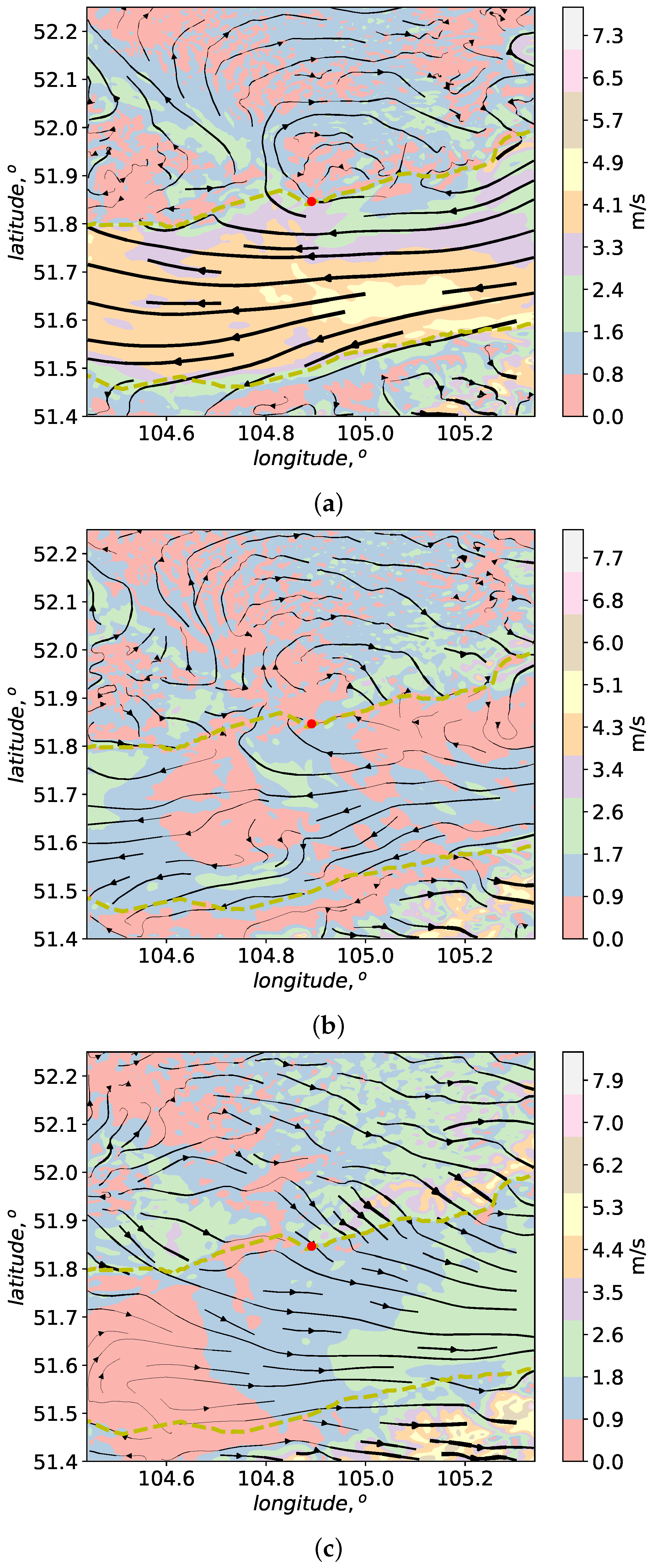


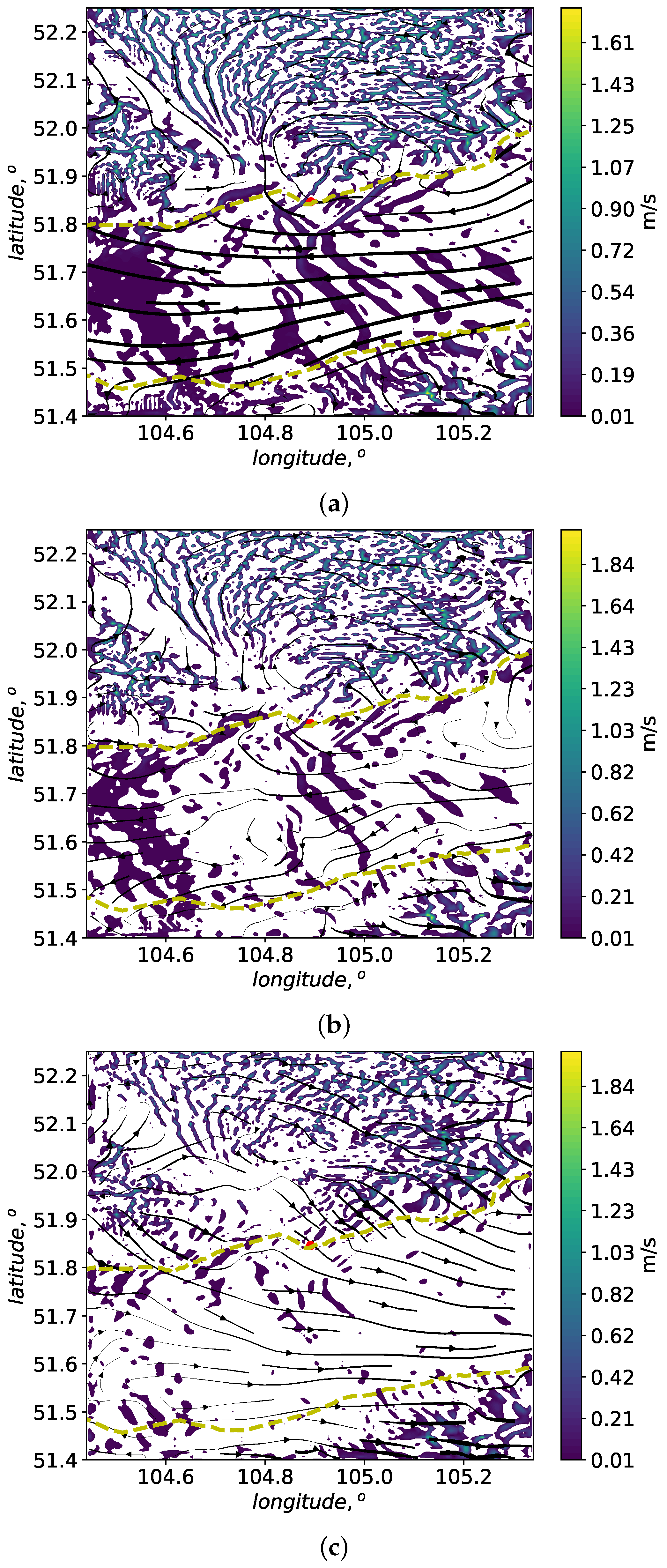
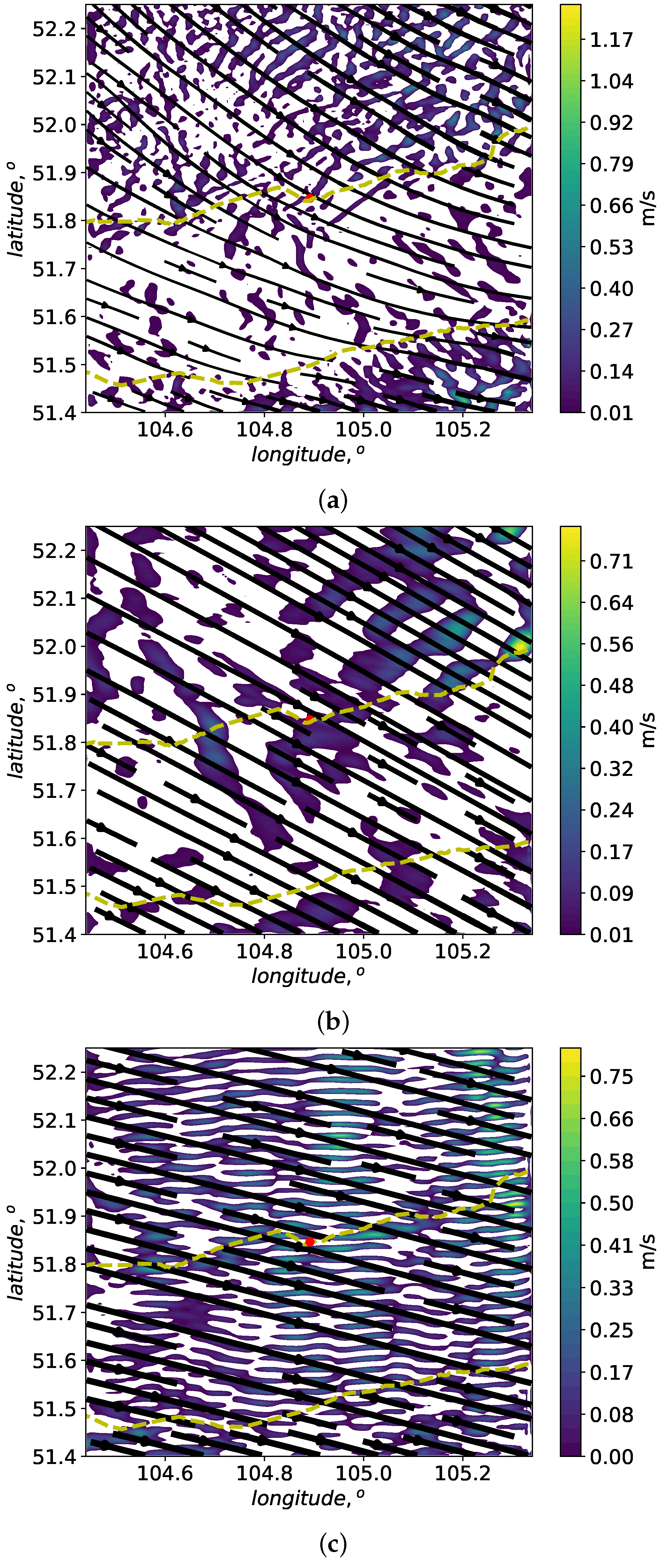
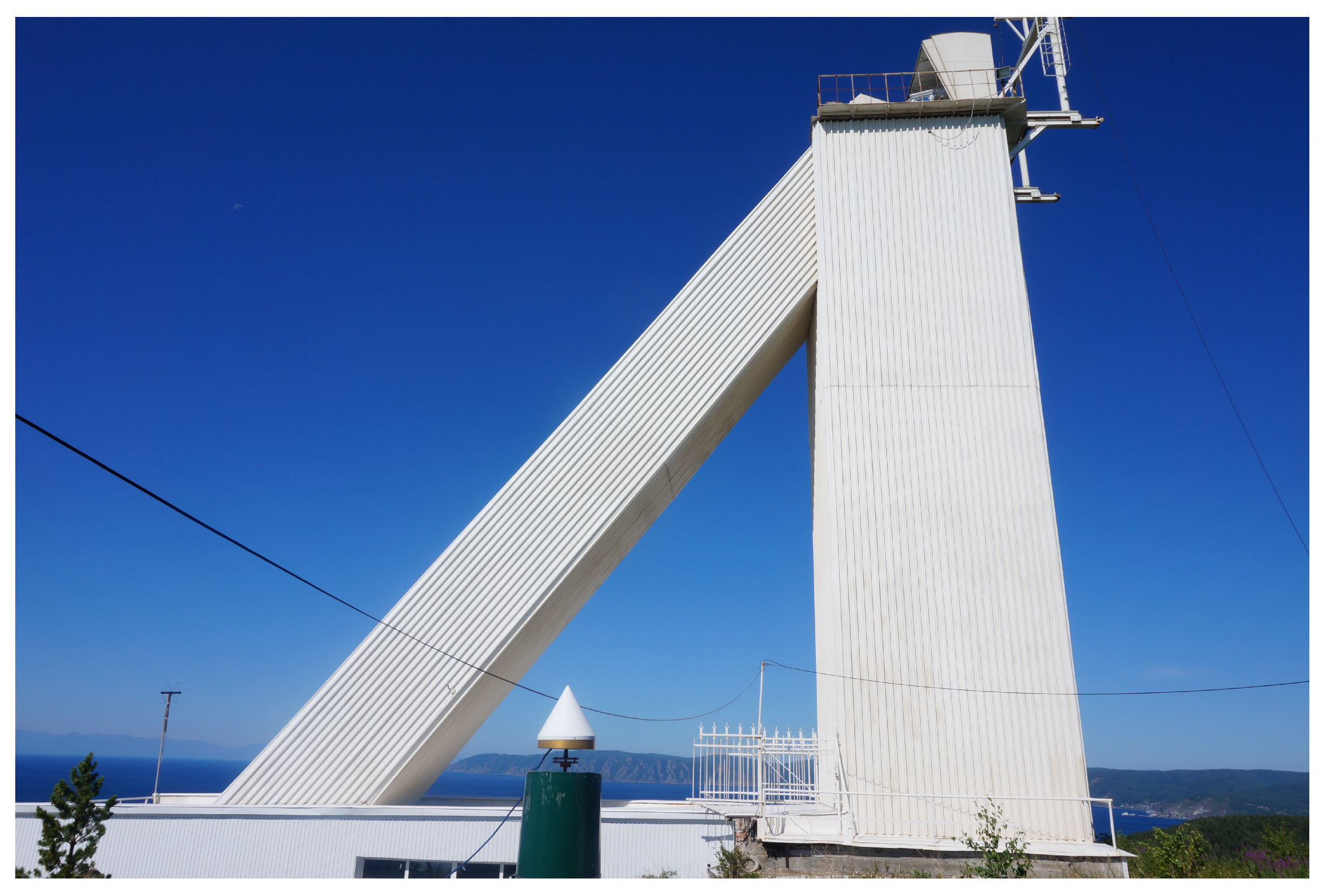
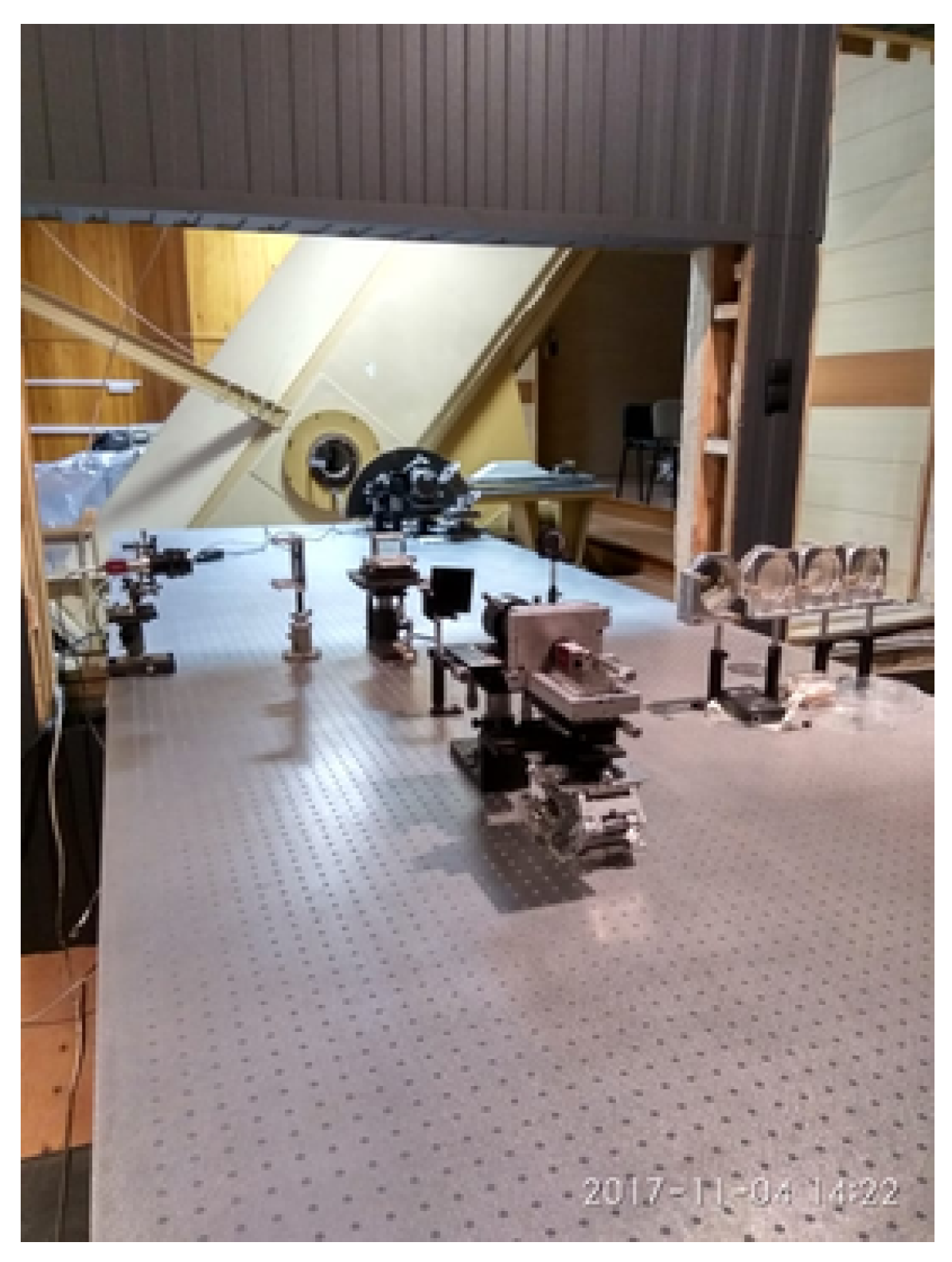
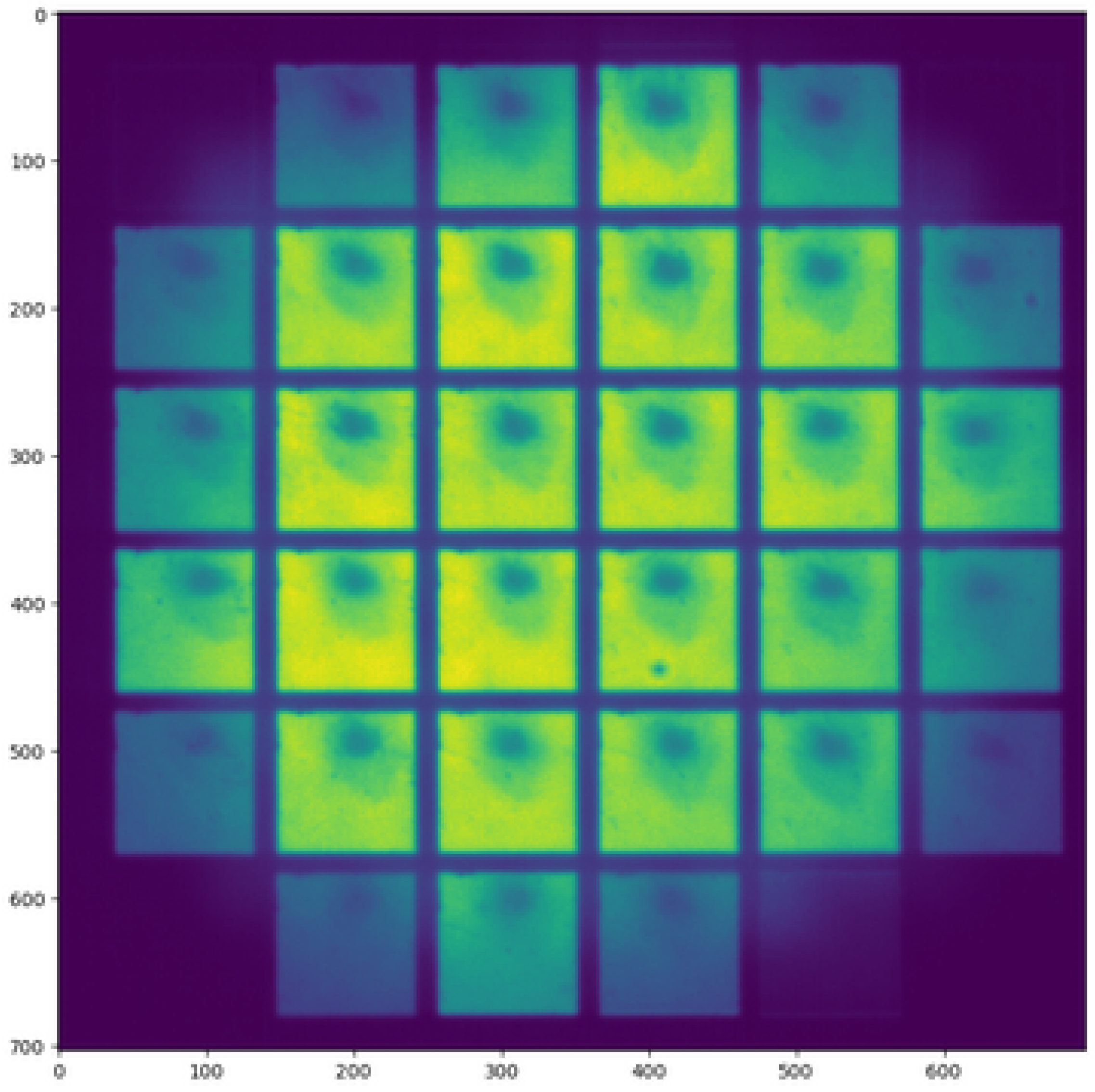
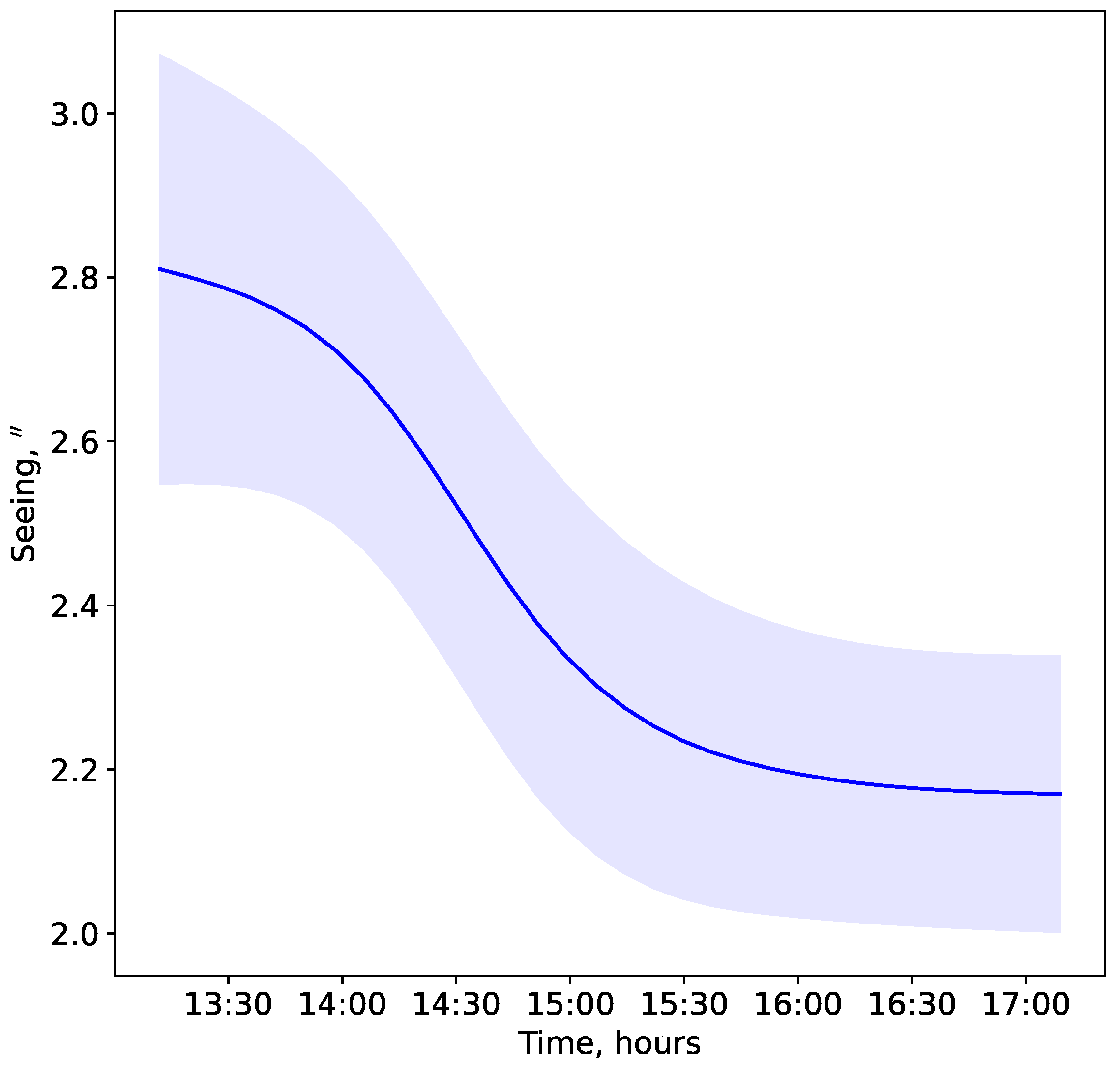
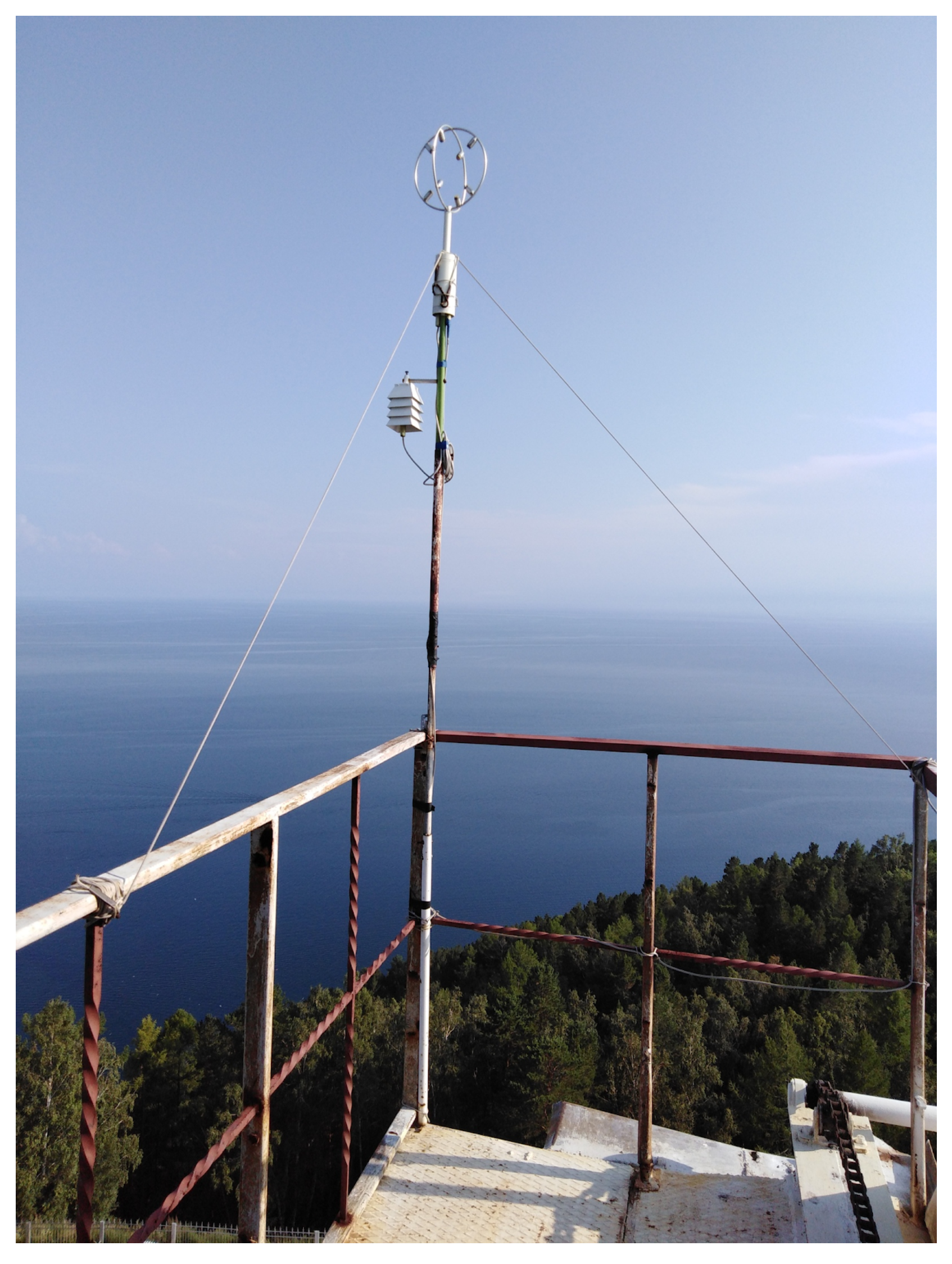
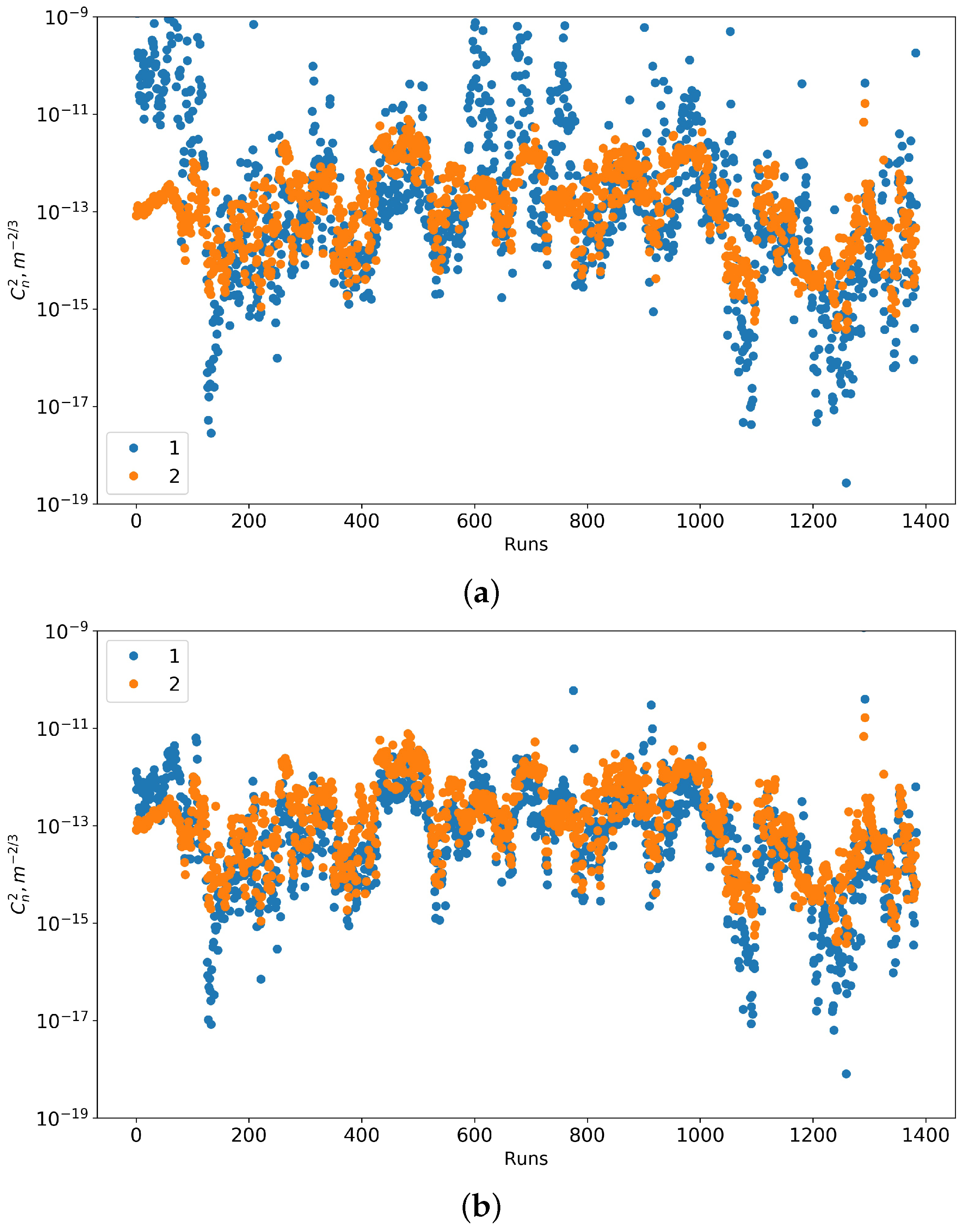

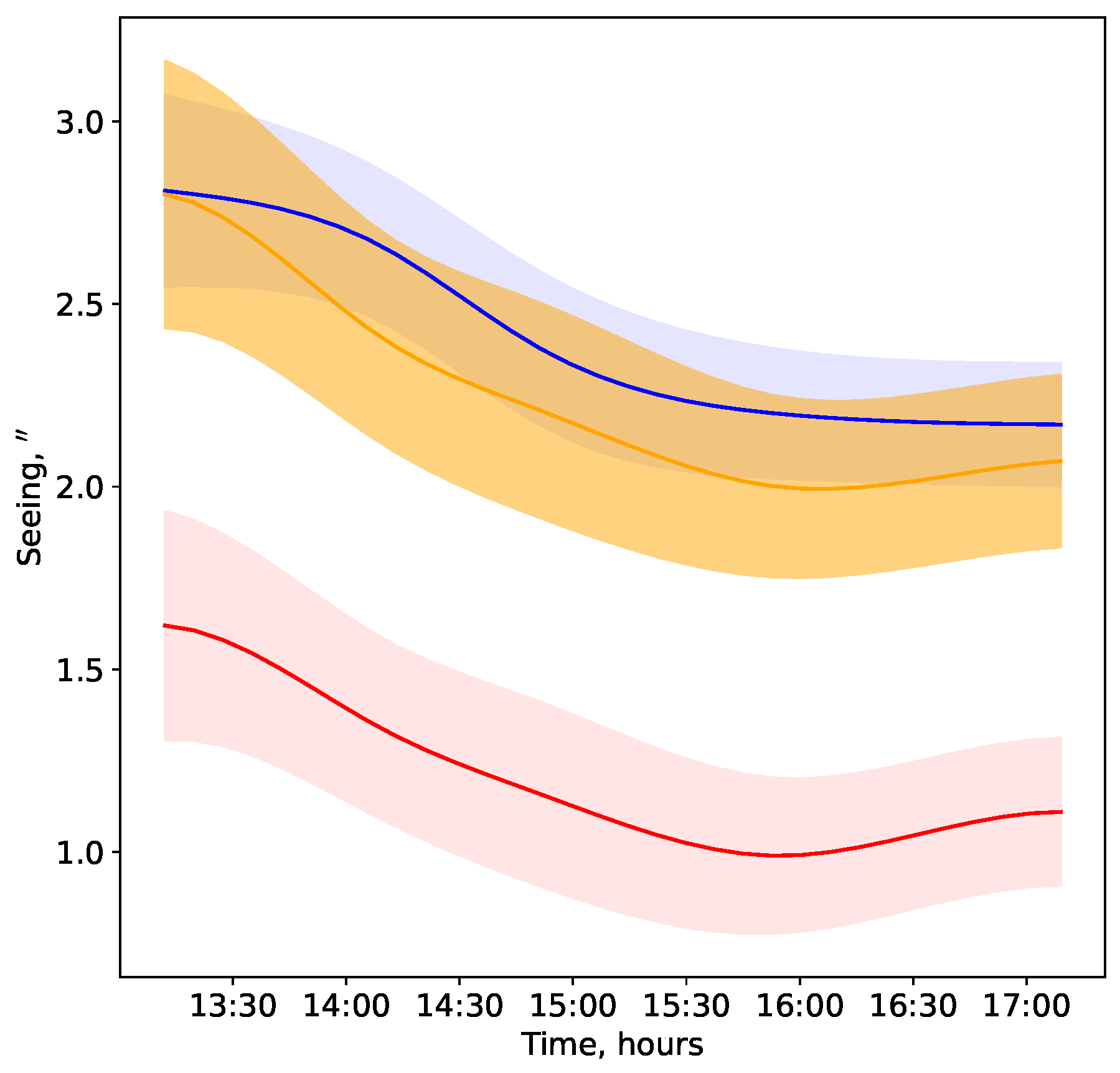
| Physical Schemes of Parametrization | Description |
|---|---|
| Yonsei University scheme | Atmospheric boundary layer |
| MM5-similarity scheme | Surface layer |
| Kain–Fritsch scheme | Cloudiness |
| Simple scheme based on Dudhia | Short-wave radiation |
| Rapid Radiative Transfer Model scheme | Long-wave radiation |
| Thompson scheme | Microphysical processes in clouds |
| RUC scheme | Land surface model |
| Parameter | Value |
|---|---|
| Aperture diameter | 760 mm |
| Used aperture diameter | 600 mm |
| Focal length | 40 m |
| Radiation wavelength | 535 nm |
| Number of subapertures | 6 × 6 |
| Equivalent size of subaperture | 10.0 cm |
| Angular pixel size | 0.3 /pix |
| Frame frequency | 100 Hz |
| Exposure | 30 ms |
| MAE | STD | Seeing, | ||||
|---|---|---|---|---|---|---|
| 42 | 1.64 | 0.48 | 1.1 · 10 | 3.9 · 10 | 13.0 | 1.15 |
| 2.1 | 10 | 0.80 | 1.1 · 10 | 2.5 · 10 | 7.7 | 2.25 |
| 2.5 | 8 | 0.88 | 8.0 · 10 | 9.5 · 10 | 6.0 | 2.43 |
Disclaimer/Publisher’s Note: The statements, opinions and data contained in all publications are solely those of the individual author(s) and contributor(s) and not of MDPI and/or the editor(s). MDPI and/or the editor(s) disclaim responsibility for any injury to people or property resulting from any ideas, methods, instructions or products referred to in the content. |
© 2023 by the authors. Licensee MDPI, Basel, Switzerland. This article is an open access article distributed under the terms and conditions of the Creative Commons Attribution (CC BY) license (https://creativecommons.org/licenses/by/4.0/).
Share and Cite
Shikhovtsev, A.Y.; Kovadlo, P.G.; Lezhenin, A.A.; Gradov, V.S.; Zaiko, P.O.; Khitrykau, M.A.; Kirichenko, K.E.; Driga, M.B.; Kiselev, A.V.; Russkikh, I.V.; et al. Simulating Atmospheric Characteristics and Daytime Astronomical Seeing Using Weather Research and Forecasting Model. Appl. Sci. 2023, 13, 6354. https://doi.org/10.3390/app13106354
Shikhovtsev AY, Kovadlo PG, Lezhenin AA, Gradov VS, Zaiko PO, Khitrykau MA, Kirichenko KE, Driga MB, Kiselev AV, Russkikh IV, et al. Simulating Atmospheric Characteristics and Daytime Astronomical Seeing Using Weather Research and Forecasting Model. Applied Sciences. 2023; 13(10):6354. https://doi.org/10.3390/app13106354
Chicago/Turabian StyleShikhovtsev, A. Y., P. G. Kovadlo, A. A. Lezhenin, V. S. Gradov, P. O. Zaiko, M. A. Khitrykau, K. E. Kirichenko, M. B. Driga, A. V. Kiselev, I. V. Russkikh, and et al. 2023. "Simulating Atmospheric Characteristics and Daytime Astronomical Seeing Using Weather Research and Forecasting Model" Applied Sciences 13, no. 10: 6354. https://doi.org/10.3390/app13106354
APA StyleShikhovtsev, A. Y., Kovadlo, P. G., Lezhenin, A. A., Gradov, V. S., Zaiko, P. O., Khitrykau, M. A., Kirichenko, K. E., Driga, M. B., Kiselev, A. V., Russkikh, I. V., Obolkin, V. A., & Shikhovtsev, M. Y. (2023). Simulating Atmospheric Characteristics and Daytime Astronomical Seeing Using Weather Research and Forecasting Model. Applied Sciences, 13(10), 6354. https://doi.org/10.3390/app13106354









